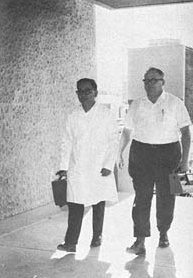Oyama, Vance I. (1922–1998)
Vance Oyama was an American biochemist who served as the chief of NASA's Exobiology Branch at the Ames Research Center. Oyama was a veteran of life detection experiments on Apollo lunar samples and father of the Viking gas exchange experiment (GEX). Along with Wolf Vishniac and Harold Klein, Oyama was among the most optimistic of the scientists working on the Viking biology experiments about the prospects of detecting Martian life. Ironically, his experiment gave the least biologically favorable result of the three onboard the spacecraft and Oyama subsequently became convinced that the activity registered in the soil samples could best be explained chemically.
 |
| Vance Oyama (left) and Leonard P.
Zill
|
Oyama's hypothesis about Viking results
In an effort to explain the puzzling results obtained by the Viking biology experiments, Oyama began by assuming that intense solar ultraviolet radiation breaks down, by photodissociation, carbon dioxide (CO2) in the Martian atmosphere into activated carbon monoxide (CO) and single atoms of oxygen (O). The carbon monoxide is further broken down into its constituents, carbon and oxygen. Some of the single-atom carbon then combines with carbon monoxide to produce carbene (C2O). This in turn combines with carbon monoxide to form carbon suboxide (C3O2) which links together to make a carbon suboxide polymer – a substance that, interestingly, has a reddish cast. The presence of this polymer in the Martian soil, together with the use of radioactive carbon-14 as a labeler, are the keys to understanding the curious results of the Viking pyrolytic release (PR) experiment, claimed Oyama. The decay of carbon-14 into nitrogen-14 releases beta particles which have enough energy to break carbon-carbon, carbon-hydrogen, and carbon-oxygen bonds, and thus activate the carbon suboxide polymer. In this energized state, the polymer is able to incorporate the labeled carbon monoxide gas made available to the sample. Upon pyrolysis, the polymer produces about 4% of the original carbon suboxide (monomer) with a carbon-14 label. This molecule adheres to the experiment's organic vapor trap and with subsequent heating is released giving rise to a "second peak" seen in the Viking PR data.
To account for the results of his own Viking gas exchange experiment, Oyama assumed that the same photochemical breakdown that produces carbon suboxide also leads to the formation of activated oxygen atoms. When these atoms strike alkaline earths, such as the oxides of magnesium or calcium in the surface soil, they combine to form superoxides that release oxygen upon exposure to water vapor. Less oxygen was released by the GEX experiment at the Viking 2 (Utopia Planitia) site than at the Viking 1 site (Chryse Planitia), suggested Oyama, because the greater amount of water vapor at the more northerly site had already freed some of the oxygen in the superoxides near the surface.
In his explanation of the most intriguing of the biology tests, the Viking labeled release (LR) experiment, Oyama built upon an idea first suggested by John Oro, of the molecular analysis team (responsible for the Viking gas chromatograph-mass spectrometer). Oro had suggested early on that the results from both the GEX and LR experiments were due to the presence of peroxide-like materials in the Martian soil. In Oyama's view, hydrogen peroxide formed photochemically in the atmosphere and reacted with a catalyst on the surface of the soil grains to form oxygen which then diffused into the grains, reacting with the alkaline earths and metals to form superoxides. Atmospheric water vapor converts the superoxides to peroxides, which combined with water in the LR nutrient to form hydrogen peroxide. This in turn oxidized the labeled components of the nutrients to release the observed labeled carbon dioxide. As for the observed release of oxygen, Oyama pointed to what happens when hydrogen peroxide, a commonly used disinfectant, is applied to a wound. Bubbles of oxygen form as a result of the catalytic action of iron (present in blood hemoglobin) on hydrogen peroxide. A similar process operates on Mars, but in this case, suggested Oyama, the catalyst is probably a form of iron oxide known as maghemite.


